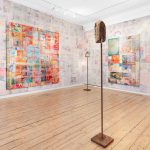“In 2009, I visited the exhibition Picasso and the Masters at the Grand Palais in Paris, which included works by artists like Caravaggio, El Greco, and Paul Cezanne, all of whom influenced Picasso. But there was not a single African mask. We know that African masks clearly influenced Picasso’s Demoiselles d’Avignon and the work of some of his contemporaries such as Georges Braque. Omitting them from this exhibition was an insult to the traditional art of Africa.
In response to this exhibition the first thing I did was to make a work that simply showed to the audience how Cubism was invented. I took an old mask that I found in a market in Dakar—not a Senegalese one but a copy of a traditional Dogan mask. I plastered on mirror pieces following the angles of the mask. After I had put on five pieces, I looked at the mask and saw myself completely fragmented, so I continued to cover the whole surface. This mirror mask is showing everybody who looks at it a Cubist portrait of themselves. Its reference to the influence of African art on Picasso’s art is very simple and direct.”
— Kader Attia
Lehmann Maupin is pleased to announce Disfigurations, a collaborative exhibition featuring London-based artist Mandy El-Sayegh and Berlin-based artist and curator Kader Attia. Attia and El-Sayegh share a deep interest in the underlying forces that shape our contemporary world—from the histories of colonialism, to the metastasis of the attention economy, to the impact of the infinite scroll on visual culture. Disfigurations places their work in dialogue to explore these ideas through fragmentation, part-to-whole relationships, and elements of fusion and synthesis, especially suture and collage.
Conceptualized as a visual conversation between El-Sayegh and Attia, Disfigurations brings the two artists together for the first time, presenting new sculptures from Attia’s acclaimed Mirrors and Masks series alongside El-Sayegh’s image-rich, densely layered canvases.
El-Sayegh is known for her transformation of exhibition spaces, often covering walls and floors with latex, paint, and other media to create large-scale immersive environments. Her work unites a diverse array of symbols and objects—El-Sayegh references a range of advertisements, international currency symbols, pop cultural imagery, and autobiographical materials (such as her father’s Arabic calligraphy) as source imagery. Collected and collaged into a single canvas, drawing, or vitrine, her critical juxtapositions coax new meanings out of both familiar and unfamiliar signifiers to reveal connective threads through personal and shared histories.
Born and raised between the suburbs of Paris and Algeria, Attia’s dynamic practice is informed by his multicultural experience. Spanning sculpture, photography, installation, and video, his researched-oriented work is rooted in anthropology, history, and politics. For over a decade, Attia has focused on the concept of injury and repair (whether physical, spiritual, cultural, or psychological), especially as it relates to the desire of Western cultures to shape the natural world or control the passage of time.
Attia is a connoisseur of tribal art and traditional African objects, and in his Mirrors and Masks series he intervenes into replicas of African masks through the application of fragmented mirrors. Each mask creates a Cubist portrait of the viewer and poetically illustrates the influence of African art on artists like Picasso and the broader development of Cubism. In Disfigurations, these sculptures investigate the ways that colonialism forces the reconstruction of individual and cultural identities, and symbolize Western culture’s amnesic memory of the history of non-Western cultures. As the masks confront viewers with their own fragmented self-portrait, they also suggest a deeper, fractured self, gesturing towards Attia’s recent interest in the fragmented subjectivity that arises from continuous connection across multiple online channels—a hallmark of the digital age.
Attia’s mirrored masks are set in dialogue with a new body of works on canvas by El-Sayegh. The saturated and kaleidoscopic palette of El-Sayegh’s work responds organically to the refracted light in Attia’s fragmented surfaces. Created through a method of free association, these highly layered paintings function as membranes, absorbing disparate elements into their material “bodies.” As such, El-Sayegh’s paintings are themselves composed of fragments, their disjointed images and headlines diffused into hand-painted motifs and silkscreened ephemera. Attia’s reflective sculptures further fragment El-Sayegh’s paintings, enhancing their aesthetic depth and unspooling their internal narratives. This multiple mirroring creates a “mise en abyme” of reflective surfaces and repeated patterns across the exhibition, bringing new work by El-Sayegh and Attia together in a series of close encounters.
Press release from Lehmann Maupin, New York, Hong Kong, Seoul and London



